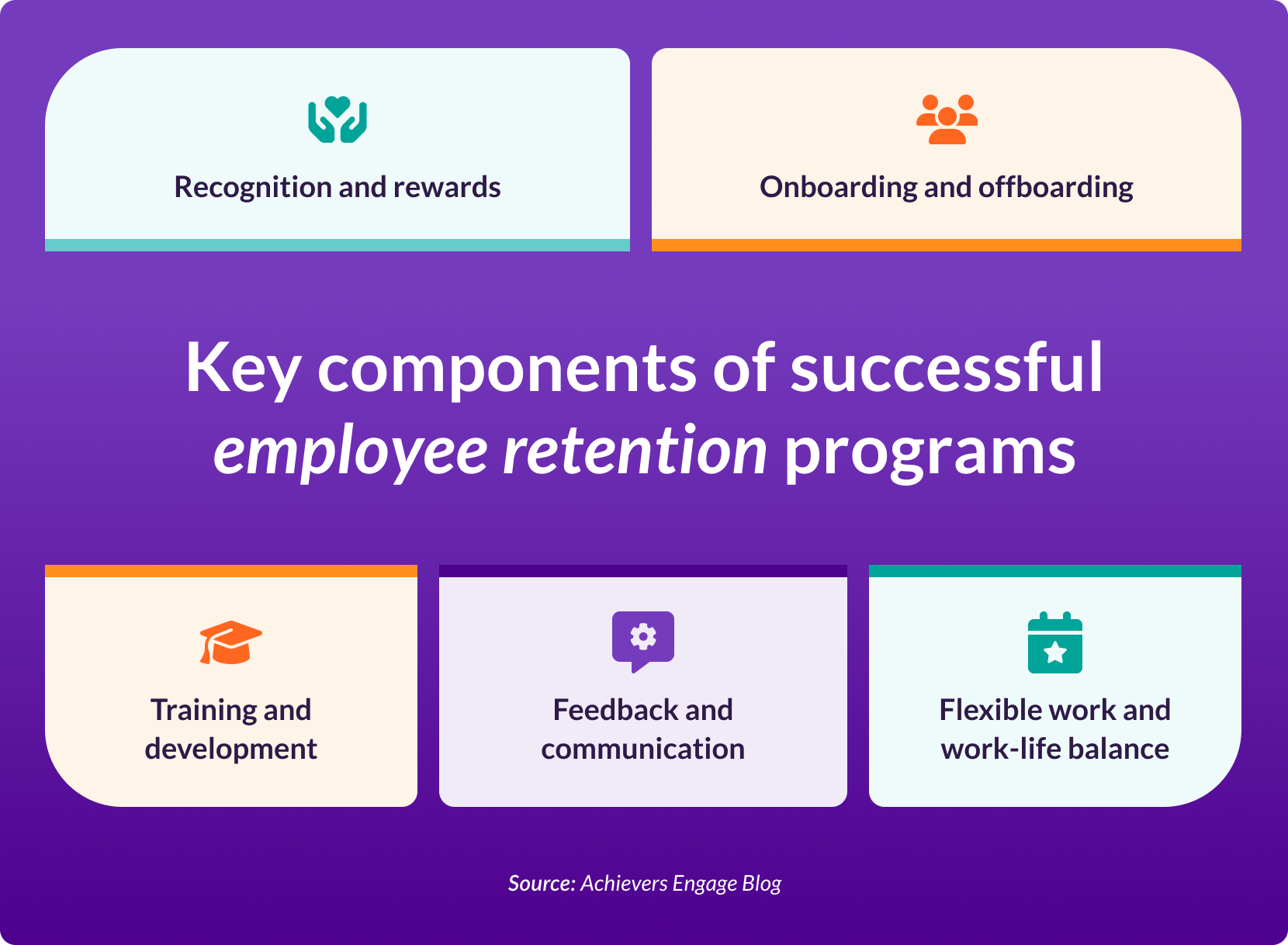Table of contents
An organization’s most valuable assets are their people, and if they are the engine powering the success and profits of your company, employee retention programs are the fuel that keeps them going. Read how to kickstart and accelerate your employee retention program today.
What is an Employee Retention Program?
Think of employee retention programs as the secret sauce to your team’s engagement, motivation, and commitment. To deliver the best taste and outcome, this secret sauce requires different spices and seasoning, meaning strategies and initiatives to create an environment where employees feel valued and excited to come to work every day. From a stellar onboarding and internal wellness program to an employee software that optimizes the employee experience, it is all about creating an engaging workforce to enhance productivity and keep your top talent on board.
Why are employee retention programs important?
No employer wants to lose their top talents to other organizations. Plus, it costs more to recruit than to retain. The cost to replace an existing employee is three to four times that position’s salary, not including losses in valuable time, knowledge, productivity, or cultural impact. By focusing on reducing turnover and improving job loyalty, these programs can build a strong and cohesive team that’s ready to tackle any challenge. Sounds like your company’s key objective? Let’s dive deeper into the whats, whys, and hows of an effective retention program.
Key components of successful employee retention programs
1. Recognition
When was the last time your employees got recognized for their hard work? Lack of recognition is among the top reasons employees look for another job. Onsite employees in demanding industries, such as healthcare and manufacturing, are suffering a recognition deficiency and experiencing frequent burnout and a high turnover rate. Practicing employee recognition starts with a culture of recognition where your organization regularly and meaningfully acknowledges employees’ small and big wins. An employee recognition platform can make this process easier by providing a consistent platform to celebrate achievements, reducing burnout, and helping retain valuable talent.
2. Compensation
87% of US workers believe that compensation should be the top priority for employers. In a challenging economic environment, competitive salaries and benefits provide employees with the financial stability they need and reduce the temptation to seek better-paying opportunities elsewhere. Fair compensation packages also signal to employees that their skills, efforts, and contributions are meaningfully recognized and valued by their company.
3. Onboarding
81% of employees felt overwhelmed during the onboarding process. That is no surprise since many employees use over 10 platforms and applications a day in their flow of work, and new employees often feel rushed to absorb a large amount of information in a short period of time. Companies should think of onboarding as a much longer and more fulfilling journey, express their culture through onboarding activities, and pay attention to onboarding your remote employees.
4. Rewards
What motivates you and your employees? If you’re looking to engage and motivate your workforce, you need to first understand the types of employee rewards, such as intrinsic and extrinsic rewards, and how you can take advantage of each to better connect your team. Offer rewards that matter to your employees and see your workforce’s productivity and retention grow!
5. Culture
Company culture is a cornerstone of employee retention, and building a culture that attracts, engages, and retains employees takes more than starting a few scattershot initiatives and crossing your fingers. Pay attention to the key elements that make a company culture great to stay competitive and set your employer brand apart from others.
6. Collect feedback
Only one-third of employees say they are very engaged at work, and one of the few ways employees can provide anonymous, honest, and transparent feedback to their organization is through pulse surveys. This listening tool is crucial for understanding how your employees feel about their role and organization, their motivations, opportunities and challenges. Phrase your pulse surveys questions well to let employees freely express their thoughts and don’t forget to address the comments and act on the feedback you receive.
7. Training and development
Employees want growth opportunities at work. Whether it is mentorship or involvement in new projects, strategic investments in employee learning and development can help you boost your company’s bottom line. According to Gallup, organizations that have made considerable investments in their employee development see an 11% increase in profitability and are twice as likely to retain their employees. Get started on your employee development program and see your employees thrive.
8. Flexible work arrangements
This should come as no surprise as one of the most essential elements to retaining your employees. Employees have needs and it is crucial that organizations meet their employees where they are. By embracing flexibility, organizations can position themselves as employers of choice, improving employee innovation, engagement, and retention while keeping costs low. When employees feel trusted and in control over their work lives, they’re more likely to stay committed to their roles and sustain a high level of performance.
9. Work-life balance
Work-life balance isn’t just a buzzword—it’s a game-changer when it comes to keeping your best employees on board. We spend one-third of our life at work, so building a healthy workplace where employees have the space to take care of themselves mentally and physically is the secret ingredient to a thriving and creative workforce. Employee-wellbeing should stay top of mind for organizations – you don’t want your employees to leave their job feeling burnout.
10. Communication
Communication is like the heartbeat of a thriving workplace. Whether it’s leadership’s decision to restructure a department, a manager’s choice to assign additional responsibilities or refuse a promotion, or an employee who’s struggling due to a lack of support, a failure to transparently communicate the reasoning behind a decision and the reality of a situation only breeds mistrust and disengagement. When done right, it empowers employees, strengthens bonds, and creates a workplace where people want to grow, contribute, and stay long-term. Keep the dialogue flowing, and you’ll keep your team for the long run!

Strategies for developing an effective employee retention program
Assessing current retention rates
Now that you know the key elements to building a successful employee retention program that serves your business needs and objectives, let’s ensure it works! While setting measurable goals and KPIs for your retention program is a crucial first step, calculating and analyzing your organization’s employee retention rate is also needed to evaluate whether your program achieves what you want. Refer to our retention calculation guide and see how your company is performing relative to others in the industry.
Identifying the causes of employee turnover
Turnover encompasses employees resigning, being laid off, or getting fired. There may be varying reasons why an employee leaves their company, and organizations need to be quick at identifying, reflecting, and addressing those causes. Some common causes for employee turnover are a lack of recognition and flexibility, toxic company culture and increasing burnout, poor work-life balance, non-competitive pay and benefits, and ineffective onboarding.
Identifying employee turnover is like shining a spotlight on what’s working and what isn’t at your company. By digging into the reasons behind why employees leave, businesses can take targeted actions to improve retention. Eventually, identifying employee turnover isn’t just about analyzing the past—it’s about shaping a stronger future.
Next steps for HR leaders
Most of the shared key elements to a successful and effective retention program are non-monetary. It is common to think that competitive salaries are the key factor to retain and keep employees motivated. However, salary is not the sole reason they stay at a company for a long time and most people are motivated by more than monetary incentives. Retention goes hand in hand with emotional salary – non-monetary components that contribute to an employee feeling adequately rewarded at work.
Is your organization offering emotional salaries to keep employees engaged and committed?


